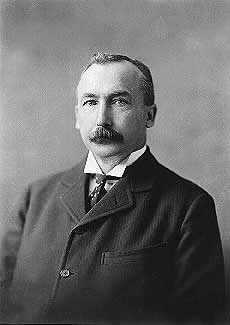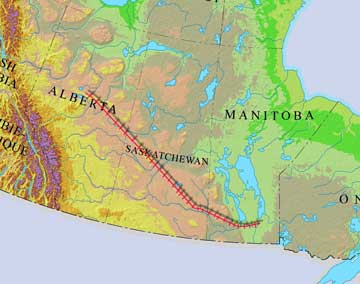|
|
||||||
|
The Immigrants Who Came Home |
||||||
| FTLComm - Ituna - Monday, April 12, 2003 | ||||||
| Were some nation building at the turn of the twentieth century and you made up a list of the things you needed in immigrants to settle a piece of land in one of the largest countries in the world you would first look at the challenges that land would pose its new settlers and from those conditions you would make up a list that most surely would be impossible to resolve. | ||||||
|
||||||
| But first we need to consider why you want the settlers in the first place. Various times in history fads develop and just like hoola hoops and leisure suits countries and entrepreneurs get hung up on something that looks popular. The nineteen century was a time of totally amazing expansion world wide as technology was opening a who realm of new activities and with those activities the lure of moving things around was overwhelming. Railroads were the fad and the rich thirsted for a railroad of their own like no other business incentive since the wild and woolly days of wind sail trading of the century before. Every corner of the earth had railroad tycoons blowing fortunes and creating havoc as they built and built and built. | ||||||
| Here in Canada the need to stitch the West Coast to the East Coast was not something that could be ignored as the railroads of the United States made a country then almost destroyed it in the railroad war known as the Civil War. Canada came into being as a result of the rebels who had broke away from Britain in 1776 now a century later they had unemployment and soldiers with no wars to fight. The had a go at killing off their aboriginal people and were rapidly depleting their own stock and began incursions into the Northwest territories. After a minor ruckus with the Metis the new country with its capital in Ottawa had built the Canadian Pacific railway and British Columbia was a part of confederation | ||||||
| But there was no way this nation could sustain itself without some people in between British Columbia and Bloor Street. Besides there were folks just itching to build more railroads. The Grand Trunk, Great Northern and a host of other upstarts were building railroads to nowhere fast. | ||||||
| The southern plains did not look promising and that was where the Canadian Pacific line had been built. Towns had sprung up along the way and there were some farmers trying to make a go of it but that was not enough. To make the country work there needed to be people North and South on the great expanse known as the plains. But any person in his right mind would definitely not want to settle where the trees had to be cut down and there was often less than one hundred days from last frost to first frost. | ||||||
| Nevertheless the railway tycoons were paying the bills for the politician's campaigns and it was decided to build a rail line across the northern prairies. But with some people the whole plan was pointless. | ||||||
 Clifford Sifton from Winnipeg became the man in charged of finding people, who would fill the bill listed at the top of this page. Most importantly and not on the list they would have to be really stupid people. Now if you have ever gone looking you will know right off that finding stupid people is really a difficult task. So you have to use railway tycoon logic, if you can't find stupid people, make them. South of Winnipeg there were a few families who had made their way to Canada from Russia. They were Mennonites, kind friendly descent folks and they were always willing to help people out. Two characters from the far eastern portion of the Austro-Hungarian empire had set out on an adventure and made it to North America and all the way out to Manitoba. They gladly received the help of some Altona folks and almost by accident someone from Sifton's office bumped into these two "Ruthanians." This is where the "make them stupid" part comes in, Sifton was a newspaper man and figured the way to get settlers for his empty country and immigrants to settle along his new railroad line was to advertise. Now the truth was no the issue here, the issue was getting settlers and Sifton's agents put up the money, a couple dollars a head and provided the two adventurers with the advertising material. This material needed serious rewriting because Clifford made sure the word "cold" and "snow" never came up. |
||||||
| If you take a look at the map at the top of this page you will discover not only the problem but also the solution. Jump on a toboggan on January day with a strong West wind behind you and a little luck , maybe a big bed sheet tied to a rope and you should be able to slide from one side of that map to the other. The countryside in southeastern Europe is pretty much like Saskatchewan without natural barriers armies, bands of pirates, armed gangs could simply wander around raising as must trouble as they wanted. Essentially the place is indefensible. | ||||||
| So easy to travel across and enough food to keep your horses going, no deserts and cheerful people to steal from it was the Las Vegas of the plunders for centuries. The Vikings modified their ocean boats and worked up and down the rivers at will setting up their head office in Kiev and from them came the "Rus". | ||||||
| There were basically three kinds of people who lived on those plains. Victims, attackers and service people who provided the horses and cattle. Farmers were found in the West and the warrior attackers for hire (Cossacks) were mostly in the central and Eastern part of what we know now as the Ukraine. Herdsmen were scattered about and tended not to be victims to the same extent as the farmers as they had a certain level of mobility. | ||||||
| Warlords in Warsaw, Budapest, Moscow harvested armies from the area when ever they felt the need for territorial expansion. Cossacks would engage Cossacks on behalf of their latest contract. Making light of this horrid tragedy is really not my intention but rather to illustrate the upper hopeless rapidity of this process. The Holy Roman Empire centred in Austria had expanded East butting up against Poles and Romanoffs and always it was the Ukrainians who were camped in the midst of a battle field. | ||||||
| The interesting thing is that the people in Eastern Austro-Hungarian Empire, Southern Polish territory and Western Russian territory were not all Ukrainian. Czechs, Hungarians, Poles, Jews and Gypsies all were mixed together and had learned to live and suffer together. So into this environment come a couple of home boys who had gone to see the world. They had some money and advertising material about the wonderful land across the sea. This was an easy decision for most people and whole villages in what Canadian immigration authorities would call "Galacia" or "Ruthania" were going home. | ||||||
| In 1971 I was in a Regina nursing home sitting talking with three guys from the same village, the kid was 86 and the old guy was in his mid nineties. They had grown up together came to Canada together and were sitting telling stories to a college student together. | ||||||
 The first war was clearly on the The first war was clearly on thehorizon and back in Canada the railroad was being built from just West of Winnipeg (Rivers) over to Melville, on to Watrous, then to Saskatoon, over to Biggar, out across the wilderness to Vegerville, then to Edomonton. The line was continued onward to Prince Rupert and down the Fraser Valley to Vancouver but the folks from Volyn, Pltavsky, Bukovina, Transcarpatia were arriving and being moved to Winnipeg then out they went to their new homes as they would spread out from the rail line which some still call the "garlic snapper belt". They would go to Roblin, up to Dauphin, settle in Saltcoats, Esterhazy, Yorkton, Kamsack, Kenora, Watson, Foam Lake, Ituna, Wakaw, Prince Albert, Marcelin, Porcupine Plain, Nipawin. Spur lines were being build into the woods and with every line came more good intentioned folks on their way home. |
||||||
| Among them would come Russian Doukhobors, a whole sprinkling of Poles and Czechs, there would be a Lithuanian or two, many Germans, but mostly they were Ukrainians from a remarkably central location now spread out across hundreds and hundreds of miles. | ||||||
| Despite being lied to, being tricked and brought to hardship that would make the battle fields in Europe look not all that bad, they persevered. They really had no other choice, once here, they had to make the best of it and without a doubt they have far exceeded any parameters someone might have thought up for the ideal settler. The Ukrainians were given a hard time in Europe and when they got to Canada a whole lot of them were put into concentration camps because they were "from" enemy territory, they were actually from the Austrian Empire, the bad guys in World War I. But they handled that and they handled, the drought of the thirties, the Canadian liquor laws and even cable TV. | ||||||
| The key to their incredible success was and continues to be their culture. They have never had doubts about who they are. Their ethnic identity is not dependent upon language but upon a powerful sense of self and cultural identity. Wearing their names proudly and able to poke fun at themselves and everyone around them. From the time they set up a tent until their grandchildren began graduating from University they have known that this was their land, they went off in thousands to defend their land in 1939 and in every corner of Canada they feel at home and are accepted. | ||||||
| References: | ||||||
Hutzul people of the Carpathian mountains and the design they use |
||||||
Ukrainian Robin hood story http://members.tripod.com/warholic/Dovbush.htm |
||||||
|
|
||||||
Anniversary of ejection of 140,000 Ukrainians from the homeland (Volyn) |
||||||
|
|
||||||
Ukrainiane Saints (volyn) http://www.unicorne.org/orthodoxy/articles/saints_icons/saints_new/volyn.htm |
||||||
|
|
||||||
Information about the Volyn Oblast http://www.ukrainebiz.com/Articles/VolynFacts.htm |
||||||
|
|
||||||
Information on the Poltavsky region of the Ukraine http://www.ukraine-hotel.com/poltava/poltava_en.htm |
||||||
|
|
||||||
Bukovina from the centre for Russian studies http://www.nupi.no/cgi-win/Russland/etnisk_b.exe?Ukrainian |
||||||
The name for a male dance move - Kozachok |
||||||
An impressive and detailed story of the persecution of the people of the Ukraine during the Stalinist years of Russia. |
||||||
Business promotion for modern day Ukraine http://www.bizukraine.com/ |
||||||
Time chronology of the Ukraine http://www.brama.com/ukraine/history/ |
||||||
|
|
||||||
Excellent document site detailing the history of the Ukraine http://www.infoukes.com/history/ |
||||||
|
|
||||||
Brief but straight forward telling of the story of the History of the Ukraine |
||||||
|
|
||||||
An official site spelling out the history of the Ukraine |
||||||
|
|
||||||
Canadian Immigration web site and story of Clifford Sifton |
||||||
|
|
||||||
Outstanding account of Canadian immigration and the role of Clifford Sifton |
||||||
Canadian Northern |
||||||
The Second National Policy, This interesting document views Canada in relation to other countries in the world as it developed explaining the reasons for some of the decisions made at the turn of the twentieth century. http://www.upei.ca/~rneill/canechist/topic_15.html |
||||||
|
|
||||||
|
|
